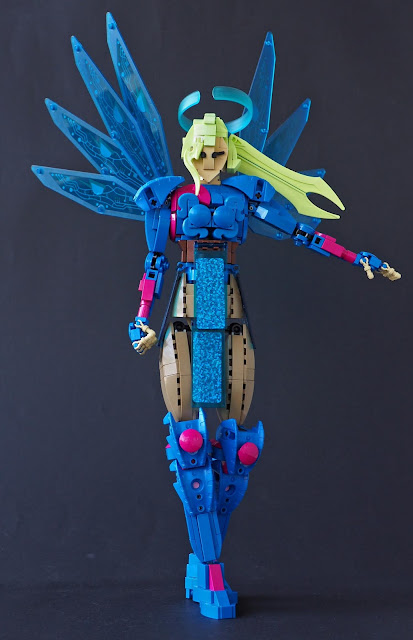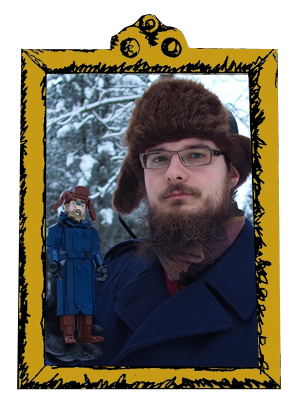
The Blue Angel of Hallow is a superdigital being who watches over multimedia connections, protecting people from malignity and sourness. As a build, she was sort of counteraction to red-and-black series of characters and new "red period" of creations overall; I wanted to do something bit similar but simply in blue, which is vibrant and common colour, and while not very exciting, offers wide range of parts, including lot of curved slopes. I mixed together some magenta, which is exciting shade and also quite beautiful. I didn't have that much of it, but it felt enough to be blasted into a creation.
I began with the lower legs. Blue Carapar armour was the key piece. It comes only in one Power Miners set, which I don't even have, but I have acquired six from some other sources; I'm not sure but I might have got one or two of them while building this, which sounds like destiny or something. Anyway, the knee joint is behind the upper pair of these parts on leg, so it acts as an individual knee pad. I like the layered look they give, and bit of magenta mudguard that trims the knee joint behind them. The shoes are quite usual boot type, again hiding the grey ball socket, as those buggers seem to be colour blocked forever. The upper legs are dark tan to bring some contrast to the bright colours; Like she would wear a pair of ordinary if high-waist trousers under the armour. The shape is quite flowing, and I was afraid it would look too thin near the hip joint. Fortunately the "loincloth" piece hides most of the gap.

The loincloth, or more like skirt, is a trick I've been waiting to use for some time. They're solar panels from 1999 Town Space Port theme. The actual side of the sticker sis cool, with silver glittery pattern and some numbers, but the clear treasure lies underside - deep blue, glittery pattern. Four are used there, and they bring otherwordly yet modern feel to the build. They also make the blueness of the build more consistent. They hang (well, one of the really doesn't) from the brown belt. Above it the breastplate recycled the design from Ruki, a Klaanon creation from 2016. The cat tail piece is another one I wanted to use there, as I hardly ever build anything blue, and they seemed to fit the elegant nature of the design here. Around them there is some asymmetry with the colours. Such design element felt fitting and was supported by the inventory of magenta parts available. Mudguards again form the holes for the arms. It's an old trick I've been using on some Ankh-Morpork City Watch characters, but the bright colours here bring it up better. I have one 1x2 curved slope wedge in blue, so it was ditched here for absence of better use; 2x2 macaroni tile on the "magenta side" has some likeness of shape theme of the cat tail parts under it.
Carapar armour parts on the shoulders are attached to joints in way that they can slide over the shoulder, keeping the same silhouette. They're supposed to look like stuffed shoulders on certain types dresses, and I think they do their job nicely. I like using unusual parts like those. The arms overall are quite basic, if very SNOT heavy; Then again, these days, what isn't? There is a one innovation though, and that is connecting the new-ish round-plate-with-bar into anti-stud side of a headlight (heavy hobby lingo here, sorry) so the small support in the middle of bar part slides inside the headlight, thus eliminating the otherwise irritating two millimeter wide gap. Great yeah? I don't have any 2x2 round tiles in blue or magenta, so the inner side of elbow joint uses a very studdy design of 1x1 round plate on 2x2 one. I was afraid it would look ugly, but looking at the photos now, I barely notice it; I've never been a perfectionist, fortunately.

The angel's wings use Insectoid wing parts. They're cool: Extraordinary, cheap in second hand and flashy. The print side in on the back, to emphasize blueness and match the inverted skirt panels. The connection is bit unorthodox, but works; some pulleys are used to connect four wing parts side by side. They also went through several connections - the first one had been around for several years, I think it was a tablescrap from an preliminary version of Gale Serpent.
I wanted the hair be green. It felt fitting for the overall vibrant, modern feel of the creation, and I had plenty of suitable pieces. Colour options were very bright green and lime green, and I ended up in the lighter of the two shades; The lime green hair will be on upcoming build that is almost finished. Only missing part in very bright green is a clip to connect the flame barb bang. It is while now, and blends quite well in. I'm particularly happy with the twin sword ponytail. It's quite graphical, but natural enough, and rather flowing. The halo is a Clickits wrist band; I like the asymmetry of it.
-Eero





































































.jpg)





